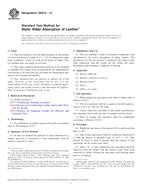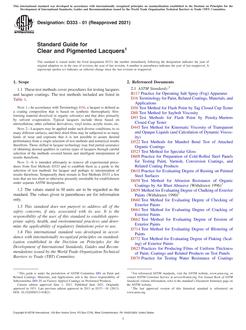1.1 These test methods cover the testing of general-purpose (Grade A), low-temperature (Grade B), and high-temperature (Grade C) nonrigid vinyl chloride polymer tubing, or its copolymers with other materials, for use as electrical insulation. For the purpose of these test methods nonrigid tubing shall be tubing having an initial elongation in excess of 100 % at break.
Note 1 – These test methods are similar but not identical to those in IEC 60684–2.
1.2 The values stated in inch-pound units are to be regarded as standard, except for temperature, which shall be expressed in degrees Celsius. The values given in parentheses are mathematical conversions to SI units that are provided for information only and are not considered standard.
1.3 The procedures appear in the following sections:
| Procedure | Section | ASTM Reference Standard |
| Brittleness Temperature | 43-45 | D746 |
| Corrosion Tests | 74-85 | D1000 |
| Dielectric Breakdown Voltage at High Humidity | 65-73 | E104 |
| Dielectric Breakdown Voltage | 58-64 | D149 |
| Dimensional Tests | 8-14 | D374 |
| Effect of Elevated Temperatures | 25-36 | D412 |
| Flammability Test | 15-21 | |
| Oil Resistance Test | 35-42 | D471 |
| Penetration Test | 46-51 | |
| Sampling | 6 | |
| Strain Relief Test | 68-73 | |
| Tension Test | 22-24 | D412 |
| Test Conditions | 7 | |
| Volume Resistivity | 52-57 | D257 |
1.4 This standard does not purport to address all of the safety concerns, if any, associated with its use. It is the responsibility of the user of this standard to establish appropriate safety and health practices and determine the applicability of regulatory limitations prior to use. For specific hazard statements, see Section 5.
1.5 For fire test caveats, see Section 15.
15.1 This is a fire-test-response standard. The test procedure described measures the resistance of the tubing to ignition or the spread of flame after ignition when tested under the specified conditions.
15.2 This standard is used to measure and describe the response of materials, products, or assemblies to heat and flame under controlled conditions, but does not by itself incorporate all factors required for fire hazard or fire risk assessment of the materials, products, or assemblies under actual fire conditions.
15.3 Fire testing is inherently hazardous. Adequate safeguards for personnel and property shall be employed in conducting these tests.
25.1 The effect of elevated temperature is indicated by the changes in ultimate elongation and weight caused by exposure of the tubing to elevated temperatures for a specified time under controlled conditions of air circulation.
Product Details
- Published:
- 10/01/2009
- Number of Pages:
- 13
- File Size:
- 1 file , 190 KB
- Redline File Size:
- 2 files , 340 KB


